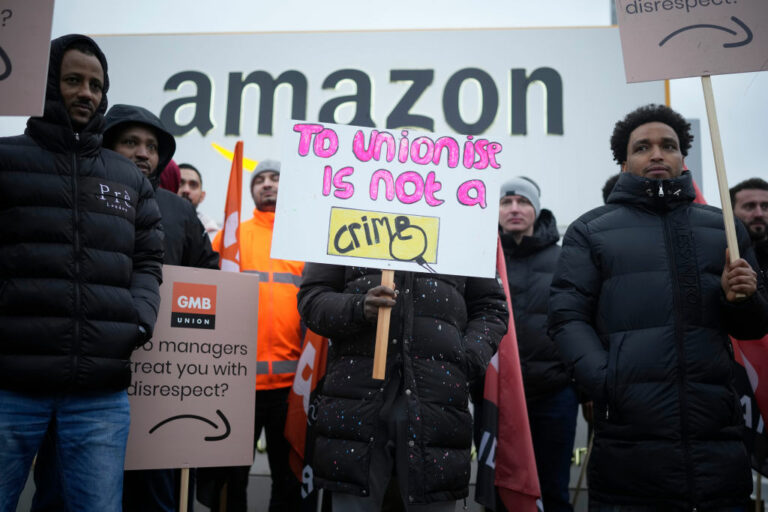A desire to strengthen relationships with carriers and build more robust delivery strategies was evident at a Retail Gazette retailer roundtable hosted in partnership with Amazon Shipping on 13 July.
Setting consumer expectations is key when it comes to e-commerce delivery, according to the retailers involved in the event – and when things go wrong, retailers are generally willing to quickly resolve customers’ problems at the risk of adding operational costs.
These issues and more were shared over a lengthy breakfast debate at the event at The Ivy, London Tower Bridge, which involved representatives from Avon, B&Q, Co-op, Everything5Pounds, Gousto, Moonpig, M&M Direct, Ocado, Prada, and Sainsbury’s.
Retail Gazette and Amazon Shipping have this month published a report, ‘Solving the Delivery Equation – how to optimise carrier costs without impacting customer service levels’, and the study formed the backdrop to the event discussions.
No retailer at the breakfast spoke of a perfect carrier experience or e-commerce operation, highlighting there is significant room for improvement when it comes to optimising this increasingly important area of their businesses.
Making the sums add up
The Solving the Delivery Equation report suggests a core challenge for today’s retailers is keeping customers happy and willing to spend amid a cost of living crisis while dealing with rising costs and complexities throughout their supply chains.
Retailers at the roundtable spoke of multiple e-commerce delivery equations in need of solving, including estimating just how much e-commerce is going to be part of their overall sales as consumer behaviour settles post-pandemic.
Other major issues to address are how carrier partners can better represent the brand they are working for, and how strong relationships with carrier account management teams can be expanded to the drivers fulfilling the final-mile delivery.
Robert Kulawik, chief operations officer at Everything5Pounds, said: “Carriers are not us – they want to be as efficient as possible and can cut corners as a result.
“Customers do not differentiate between brand and carrier. A key challenge for us as brands and retailers is to ensure the user experience our customers expect is upheld and carriers provide the required standard.”
One multichannel retailer said the business would much rather customers came to its stores because it represented a more cost-effective method of distribution, but acknowledged the genie is out of the bottle when it comes to e-commerce.
“If you’re not in the game, someone else will eat your lunch,” they warned.
A discussion about hierarchy of online delivery importance was mooted by roundtable guests, with the food retailers suggesting failed delivery to hungry customers is more of a problem than failed delivery of non-food items.
But tell that to customers who choose speedy fulfilment to get an item of clothing to their house in time for a party or special event – it would be a minefield for carriers to optimise one retailer over another because it is difficult to prioritise customer need. The younger generations expect rapid delivery options, several of the retailers agreed.
Retail Gazette has worked with Amazon Shipping on several events and reports throughout 2022 so far, and one consistent message is the lack of funds available for retailers to invest in new innovation around delivery and e-commerce.
That paints an unfair picture of finance departments as “miserly bean counters” in head office, said one retailer at this month’s event.
“The truth is that our finance team is all geared up towards how we grab new customers – and then retain them,” they explained.
Another guest added: “Finance has bought into the idea that we as a business needed to change. It is all about looking at where money can be saved and where it can be hedged for future growth – we work cross-departmentally to find creative ways to spend and save cash as our digital transformation progresses.”
Claims process ripe for a revamp
The Retail Gazette research showed “speed of reimbursement expected by customer” (38%) and “not getting paid quickly enough by carrier” (22%) were among the biggest challenges retailers cited in relation to their existing claims process.
And 41% of the retailers questioned agreed loss rates are a pain point in trying to reduce business costs. When rating ease of submitting and resolving claims with the existing delivery partner/s, 81% of retailers chose “average” or “difficult”, and 54% said the administration involved in making a claim was the biggest challenge.
A retailer at the roundtable supported these stats, saying “it’s not as joined up as it needs to be”.
One roundtabler said that business systems can often be so archaic that it takes guesswork when working out values of claims to carriers and other suppliers after failed service.
Another guest added: “The feedback around carrier services comes back loud and clear when things go wrong.
“When comparing all the different fulfilment processes we have, including click & collect, company-owned delivery, and other ways of getting goods to customers, carrier performance is rated lowest by our customers.”
Getting things right the first time is clearly the most cost-effective way of running e-commerce delivery, but the world of fulfilment is some distance from a perfect service. Research from Citizen’s Advice, published late last year, highlights the need for improved service levels across the industry.
Kulawik argued that an economic downturn is the time to provide a better service.
“The more difficult the economic environment, the better you need to be as a retailer,” he explained.
“Everyone is feeling the pinch, it’s very difficult economically, and when someone lets you down against that backdrop you are even angrier than you would be in better times.”
Packing a punch
While optimising the customer claims process is a key area of cost saving earmarked in the Retail Gazette report, packaging policy and working with partners that have made substantial technology investment were other areas earmarked for attention.
The Home Delivery Review 2021 from e-tail trade body IMRG shows 35% of consumers complaining of receiving tarnished goods via online delivery last year cited inappropriate packaging as a reason. Indeed, it’s been a consistent issue – IMRG said in each of its last three annual surveys, more than 50% of consumers complained of damaged items.
One retailer said they had changed their packaging to be non-branded in the last 18 months in an effort not to draw attention to premium items in transit, while another guest suggested light-heartedly that some unfashionable brands might be better off promoting their name on packaging as a way of deterring opportunistic thieves.
Retail Gazette’s report suggested retailers are divided when it comes to branded packaging, with 48% using branded and 52% opting for unbranded. Some 62% said they use unbranded packaging because it is cheaper, with 26% saying branding boxes represented unnecessary brand marketing.
Retailers at the roundtable agreed it was an area for further exploration.
On the subject of technology, one retailer indicated that investment in sophisticated systems over the last few years means e-commerce delivery has become easier despite the growth in online orders.
“Volume is your friend,” noted Jonathan Lodge, head of warehousing & logistics at Gousto.
“It’s about economies of scale – the more throughput, the greater opportunity there is to gather data, learn from challenges, and optimise your systems and processes.”
Luke Batten, head of enterprise sales at Amazon Shipping, who was part of the roundtable discussion, said: “Most retailers are focused on cost optimisation right now, and thanks to the digital transformation retail experienced in the pandemic e-commerce delivery is now a bigger factor in that calculation.
“While parcel delivery rates are the obvious way to compare costs across carriers and delivery partners, there are other costs to consider too – for example, the costs incurred when a delivery that goes wrong due to poor packaging, or theft, and the complex claims processes attached to all of that. Through our research with Retail Gazette we’ve highlighted these areas as places where clever retailer decision-making can make a real difference to the bottom line.”
Batten added: “As the industry gears up for peak trading, there are many ways retailers can plan and invest in e-commerce strategies that are good for both customers and the business balance sheet. The report goes into detail on this topic, and we would suggest now is the time to take action as the golden quarter of trading approaches.”
To read the full report click here.


















